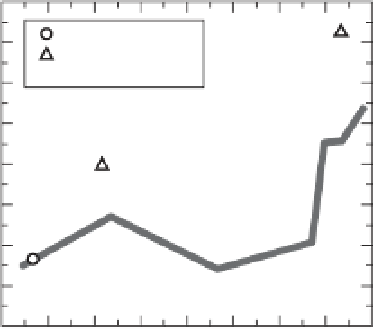Geoscience Reference
In-Depth Information
this is not a good ''test'' of lab-based conductivity
models, because the water content in the upper
mantle inferred from xenoliths is subject to large
uncertainties (see e.g., Karato, 2010, 2011). The
only reliable estimate of water content in the
mantle is the water content in the asthenosphere
that can be calculated from the water content of
MORB (mid-ocean ridge basalt) (e.g., Dixon
et al
.,
2002; Hirschmann, 2006) against which lab-based
models could be ''tested.'' Such a test was
done by Dai and Karato (2009a) who compared
their experimental results with the geochemical
estimate of water content combined with the
plausible temperature of the asthenosphere,
and showed that their experimental data are in
good agreement with these observations but the
results by Yoshino's group do not.
conductivity in the deep lower mantle may indi-
cate a high volume fraction of subducted MORB.
They also noted an effect of spin transition (tran-
sition to low spin state reduces the conductivity)
to reduce electrical conductivity in the mid-lower
mantle (
1500-2500 km) (Figure 5.19).
Dobson and Brodholt (2000) measured the
electrical conductivity of (Mg,Fe)O and suggested
that electronic conduction by ferric iron is likely
important. Yamazaki and Irifune (2003) measured
the Mg-Fe diffusion coefficients under the lower
mantle conditions. They reported diffusion
coefficients of
∼
10
−
12
-10
−
13
m
2
/s under most
of the lower mantle conditions. If the Nernst-
Einstein relation is used (Equation (5.7)), these
values are translated to the conductivity of
∼
∼
10
−
2
-10
−
1
S/m, somewhat lower than the
conductivity inferred from geophysical studies
(e.g., Olsen, 1999; Kelbert
et al
., 2009). If dif-
fusion of Mg (Fe) in (Mg,Fe)O is enhanced by
the addition of hydrogen (e.g., Demouchy
et al
.
(2007); this effect is small at low pressure but this
effect should be higher at higher pressures), the
influence of hydrogen may also be important in
the electrical conductivity in the lower mantle.
Similar studies should also be conducted on
(c) The lower mantle
Electrical conductivity
of the Earth's lower mantle is also inferred
from the analysis of electromagnetic induction
using relatively low frequencies (e.g., Olsen,
1999). Even the regional variation in electrical
conductivity of the lower mantle was inferred
down to
1500 km (Kelbert
et al
., 2009). Also
some constraints have been obtained on the
electrical conductivity of the D' layer from the
analysis of electromagnetic coupling of the core
and mantle (e.g., Nagao
et al
., 2003).
The electrical conductivity in the shallow
lower mantle is similar to that of the transition
zone. Interpretation of these results in terms
of chemical composition is difficult. Xu and
McCammon (2002) and Xu
et al
. (1998a) showed
that the geophysically inferred conductivity is
consistent with the lab data with a plausible
temperature. However, the water content in these
samples was not measured and it is impossible to
discuss the water distribution across the 660 km
from the available laboratory data.
Ohta
et al
. (2009, 2010) measured the electrical
conductivity down to the D'' layer conditions and
interpreted the inferred conductivity in terms of
the major element composition. They found that
the subducted MORB has much higher conduc-
tivity than pyrolite presumably due to the high
iron content, and suggested that the inferred high
∼
3.0
Pyrolite
2.5
MORB
Xu
et al.
(2000)
2.0
1.5
1.0
0.5
0.0
-0.5
-1.0
600
900
1200 1500
Depth / km
1800 2100 2400 2700 3000
Fig. 5.19
Electrical conductivity-depth profiles in the
lower mantle (Ohta
et al
., 2010). The low conductivity
in the middle lower mantle is due to low-spin state of
perovskite (and (Mg,Fe)O). Conductivity of MORB is
generally higher than that of pyrolite. Reproduced with
permission of Elsevier.





